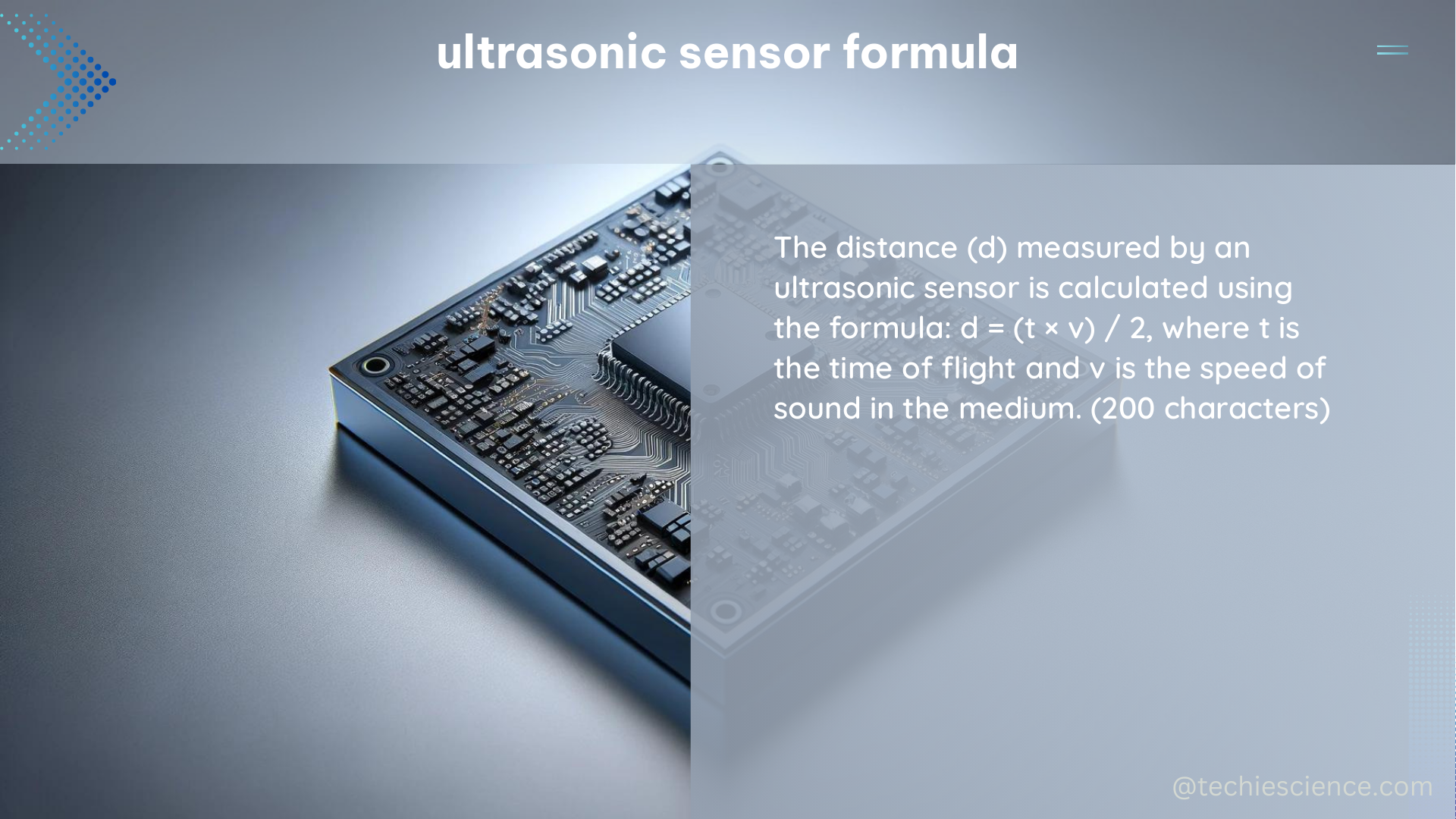The ultrasonic sensor formula for distance measurement is based on the time-to-distance conversion principle. The sensor sends out an ultrasonic wave, which travels through the air and is reflected back by an object. The sensor then measures the time it takes for the wave to return, and the distance can be calculated using the formula.
Understanding the Ultrasonic Sensor Formula
The formula for calculating the distance using an ultrasonic sensor is:
Distance = Speed of Sound in Air * (Time Taken / 2)
Where:
– Distance: The distance to the object in meters (m)
– Speed of Sound in Air: The speed of sound in air, which is approximately 344 m/s at 20°C and 1 atm of pressure
– Time Taken: The time it takes for the ultrasonic wave to travel from the sensor to the object and back, measured in seconds (s)
The formula works on the principle that the ultrasonic wave travels at a known speed (the speed of sound in air) and the time it takes for the wave to travel to the object and back is proportional to the distance.
Factors Affecting the Speed of Sound

The speed of sound in air can vary depending on several environmental factors, such as:
- Temperature: The speed of sound increases by about 0.6 m/s for every 1°C increase in temperature.
- Humidity: Humidity can also affect the speed of sound, but the effect is relatively small compared to temperature.
- Altitude: The speed of sound decreases with increasing altitude due to the decrease in air density.
To account for these variations, the formula can be modified to include a correction factor based on the specific environmental conditions:
Distance = (Speed of Sound in Air * (1 + (Temperature - 20) * 0.00117)) * (Time Taken / 2)
This modified formula takes into account the temperature variation and provides a more accurate distance calculation.
Technical Specifications of the HC-SR04 Ultrasonic Sensor
The HC-SR04 is a popular ultrasonic sensor used in many DIY projects. Its technical specifications are as follows:
- Measuring Angle: 15 degrees
- Measuring Range: 2 cm to 400 cm
- Resolution: 0.3 cm
- Operating Frequency: 40 kHz
- Operating Voltage: 5V DC
- Current Consumption: Approximately 15 mA
These specifications determine the sensor’s capabilities and limitations, which should be considered when designing a project.
Connecting the HC-SR04 Sensor to an Arduino Board
To use the HC-SR04 ultrasonic sensor with an Arduino board, you need to connect the following pins:
| HC-SR04 Pin | Arduino Pin |
|---|---|
| VCC | 5V |
| GND | GND |
| TRIG | Digital Pin 9 |
| ECHO | Digital Pin 10 |
The Arduino code to measure the distance using the HC-SR04 sensor is as follows:
#define trigPin 9
#define echoPin 10
void setup() {
pinMode(trigPin, OUTPUT);
pinMode(echoPin, INPUT);
Serial.begin(9600);
}
void loop() {
long duration, distance;
digitalWrite(trigPin, LOW);
delayMicroseconds(2);
digitalWrite(trigPin, HIGH);
delayMicroseconds(10);
digitalWrite(trigPin, LOW);
duration = pulseIn(echoPin, HIGH);
distance = duration * 0.034 / 2;
Serial.print("Distance: ");
Serial.println(distance);
}
This code sends a 10-microsecond high pulse to the TRIG pin, which triggers the sensor to emit an ultrasonic wave. The duration of the wave’s echo is then measured and converted to distance using the formula mentioned earlier.
Advanced Techniques and Considerations
-
Filtering and Noise Reduction: Ultrasonic sensors can be susceptible to environmental noise, such as interference from other ultrasonic sources or reflections from nearby objects. Techniques like moving average filtering or Kalman filtering can be used to smooth the sensor readings and improve the accuracy of the distance measurements.
-
Multiple Sensor Configurations: For more complex applications, you can use multiple ultrasonic sensors to create a 3D or 2D mapping of the environment. This can be useful for applications like robot navigation, object detection, and collision avoidance.
-
Sensor Calibration: Regularly calibrating the ultrasonic sensor can help maintain its accuracy over time, as the sensor’s performance may change due to factors like temperature, humidity, and aging.
-
Sensor Fusion: Combining the ultrasonic sensor data with other sensor inputs, such as from infrared or laser sensors, can provide more robust and reliable distance measurements in challenging environments.
-
Advanced Signal Processing: Techniques like frequency domain analysis, wavelet transforms, and machine learning can be used to extract more information from the ultrasonic sensor data, such as object size, shape, and material properties.
By understanding the ultrasonic sensor formula and its underlying principles, as well as the technical specifications and advanced techniques, you can design and implement more sophisticated and accurate distance measurement systems using Arduino and other microcontroller platforms.
References:
- Getting Distance in Inches and Cm from Ultrasonic Sensor in Arduino
- Arduino Tutorial 55: Measuring Distance With HC-SR04 Ultrasonic Sensor
- Distance measurement using Ultrasonic sensor and Arduino
- Arduino UNO: Complete Ultrasonic Sensor Guide (HC-SR04)
- Ultrasonic Sensor HC-SR04 and Arduino – Complete Guide

The lambdageeks.com Core SME Team is a group of experienced subject matter experts from diverse scientific and technical fields including Physics, Chemistry, Technology,Electronics & Electrical Engineering, Automotive, Mechanical Engineering. Our team collaborates to create high-quality, well-researched articles on a wide range of science and technology topics for the lambdageeks.com website.
All Our Senior SME are having more than 7 Years of experience in the respective fields . They are either Working Industry Professionals or assocaited With different Universities. Refer Our Authors Page to get to know About our Core SMEs.